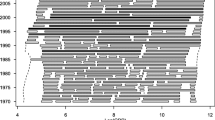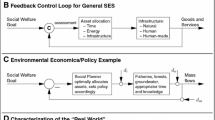Abstract
The ecological concept of resilience has begun to inform analysis of change in economy-environment systems. The linkages between resilience and the stability of dynamical systems are discussed, along with its role in understanding of the evolution of such systems. Particular linkages discussed include those between resilience, biodiversity and the sustainability of alternative states. Recent developments in modelling the resilience of joint economy-environment systems suggest the advantages of analysing change in the system as a Markov process, the transition probabilities between states offering a natural measure of the resilience of the system in such states. It is argued that this ‘emergent property’ of the collaboration between ecology and economics has far-reaching implications for the way we think about, model and manage the environmental sustainability of economic development.
Similar content being viewed by others
References
Allen, T. F. H. and T. B. Starr (1982), Hierarchy: Perspectives for Ecological Complexity. Chicago: University of Chicago Press.
Amir, S. (1994), ‘The Role of Thermodynamics in the Study of Economic and Ecological Systems’, Ecological Economics 10, 125–142.
Anderson, P., K. Arrow and D. Pines (1988), The Economy as an Evolving Complex System. Santa Fe Institute Studies in the Sciences of Complexity V. Redwood City, CA: Addison Wesley.
Aoki, M. (1995), ‘Economic Fluctuations with Interactive Agents: Dynamic and Stochastic Externalities’, Japanese Economic Review 462, 148–165.
Aoki, M. (1996), New Approaches to Macroeconomic Modeling. Cambridge: Cambridge University Press.
Arrow, K., B. Bolin, R. Costanza, P. Dasgupta, C. Folke, C. S. Holling, B.-O. Jansson, S. Levin, K.-G. Maler, C. Perrings and D. Pimentel (1995), ‘Economic Growth, Carrying Capacity, and the Environment’, Science 268, 520–521.
Arthur, B. (1992), On Learning and Adaptation in the Economy. Stanford. Food Research Institute, Stanford University.
Ayres, R. U. and A. V. Kneese (1969), ‘Production, Consumption and Externalities’, American Economic Review 59, 282–297.
Ayres, R. U. (1994), Information, Entropy and Progress: A New Evolutionary Paradigm. New York: American Institute of Physics.
Baldwin, R. (1995), ‘Does Sustainability Require Growth?’, in I. Goldin and L. A. Winters, eds., The Economics of Sustainable Development. Cambridge: Cambridge University Press, pp. 51–77.
Barnett, W. A., G. Gandolfo and C. Hillinger, eds. (1996), Dynamic Disequilibrium Modelling. Cambridge: Cambridge University Press.
Batabayal, A. A. (1997a), On Some Aspects of Resilience and the Conservation of Species. Department of Economics, University of Utah, mimeo.
Batabayal, A. A. (1997b), An Ecological Economic Perspective on Resilience and the Conservation of Species. Department of Economics, University of Utah, mimeo.
Bateman, I., A. Munro, B. Rhodes, C. Starmer and R. Sugden (1997), ‘A Test of the Theory of Reference-Dependent Preferences’, Quarterly Journal of Economics, in press.
Benhabib, J., ed. (1992), Cycles and Chaos in Economic Equilibrium. Princeton: Princeton University Press.
Brock, W. A. and A. G. Malliaris (1989). Differential Equations, Stability and Chaos in Dynamic Economics. Amsterdam: North Holland.
Clark, C. W. (1990), Mathematical Bioeconomics. New York: Wiley.
Common, M. and C. Perrings (1992), ‘Towards an Ecological Economics of Sustainability’, Ecological Economics 6, 7–34.
Conway, G. R. and E. B. Barbier (1988), ‘After the Green Revolution: Sustainable and Equitable Agricultural Development’, Futures, 651–669.
Conway, G. R. (1993), ‘Sustainable Agriculture: The Trade-Offs with Productivity, Stability and Equitability’, in E. B. Barbier, ed., Economics and Ecology: New Frontiers and Sustainable Development. London: Chapman and Hall.
Dasgupta, P. (1993), An Inquiry into Wellbeing and Poverty. Oxford: Blackwell.
Gersick, C. J. G. (1991), ‘Revolutionary Change Theories: A Multilevel Exploration of the Punctuated Equilibrium Paradigm’, Academy of Management Review 16, 10–36.
Hanna, S., C. Folke and K.-G. Mäler (1997), Rights to Nature: Ecological, Economic, Cultural, and Political Principles of Institutions for the Environment. Washington DC: Island Press.
Heywood, V., ed. (1995), Global Biodiversity Assessment. Cambridge: Cambridge University Press.
Holling, C. S. (1973), ‘Resilience and Stability of Ecological Systems’, Annual Review of Ecological Systems 4, 1–24.
Holling, C. S. (1986), ‘The Resilience of Terrestrial Ecosystems: Local Surprise and Global Change’, in W. C. Clark and R. E. Munn, eds., Sustainable Development of the Biosphere. Cambridge: Cambridge University Press.
Holling, C. S. (1992), ‘Cross-Scale Morphology Geometry and Dynamics of Ecosystems’, Ecological Monographs 62, 447–502.
Holling, C. S., D. W. Schindler, B. W. Walker and J. Roughgarden (1995), ‘Biodiversity in the Functioning of Ecosystems’, in C. Perrings, K. G. Mäler, C. Folke, C. S. Holling and B. O. Janssen, eds., Biodiversity Loss: Ecological and Economic Issues. Cambridge: Cambridge University Press.
Kingman, J. F. C. (1978), ‘Random Partitions in Population Genetics’, Proceedings of the Royal Society of London Ser. A 361, 1–20.
Levin, S. A. (1992), ‘The Problem of Pattern and Scale in Ecology’, Ecology 73(6), 1943–1967.
Levin, S. A., S. Barrett, S. Aniyar, W. Baumol, C. Bliss, B. Bolin, P. Dasgupta, P. Ehrlich, C. Folfe, I.-M. Gren, C. S. Holling, A.-M. Jansson, B.-O. Jansson, D. Martin, K.-G. Mäler, C. Perrings and E. Sheshinsky (1998), ‘Resilience in Natural and Socioeconomic Systems’, Environment and Development Economics 3(2), in press.
Liebenstein, H. (1957), Economic Backwardness and Economic Growth. New York: John Wiley.
Lipnowski, I. F. (1976), ‘An Input-Output Analysis of Environmental Preservation’, Journal of Environmental Economics and Management 3, 205–214.
Ludwig, D., B. H. Walker and C. S. Holling (1997), ‘Sustainability, Stability and Resilience’, Conservation Ecology 1(1), 7.
Mäler, K-G. (1974), Environmental Economics: A Theoretical Enquiry. Oxford: Blackwell.
May, R. (1972), ‘Will a Large Complex System be Stable’, Nature 238, 413–414.
May, R. (1977), ‘Thresholds and Breakpoints in Ecosystems with a Multiplicity of Stable States’, Nature 269, 471–477.
Meadows, D. H., D. L. Meadows and J. Randers (1992), Beyond the Limits: Confronting Global Collapse, Envisioning a Sustainable Future. Post Mills, Vermont: Chelsea Green Publishing Co.
Munro, A. and R. Sugden (1997), A Theory of General Equilibrium with Reference-Dependent Preferences. School of Economics and Social Studies, University of East Anglia, mimeo.
Myrdal, G. (1957), Economic Theory and Underdeveloped Regions. London: Duckworth.
Norton, B. G. (1990), ‘Context and Hierarchy in Aldo Leopold's Theory of Environmental Management’, Ecological Economics 2, 119–127.
Noy-Meir, I. and B. H. Walker (1986), ‘Stability and Resilience in Rangelands’, in P. J. Joss, P. W. Lynch and O. B. Williams, eds., Rangelands a Resource Under Siege. Proceedings of the Second International Rangelands Congress. International Rangelands Congress, Adelaide, pp. 21–25.
Perrings, C. (1987), Economy and Environment: A Theoretical Essay on the Interdependence of Economic and Environmental Systems. Cambridge: Cambridge University Press.
Perrings C. A. and B. H. Walker (1995), ‘Biodiversity Loss and the Economics of Discontinuous Change in Semi-Arid Rangelands’, in C. A. Perrings, K.-G. Mäler, C. Folke, C. S. Holling and B.-O. Jansson, eds., Biodiversity Loss: Ecological and Economic Issues. Cambridge: Cambridge University Press.
Perrings, C. (1995), ‘Ecological Resilience in the Sustainability of Economic Development’, Economie Appliquée 48(2), 121–142.
Perrings, C., K.-G. Mäler, C. Folke, C. S. Holling and B.-O. Jansson, eds. (1994), Biodiversity Conservation: Problems and Policies. Dordrecht: Kluwer Academic Press.
Perrings, C., K.-G. Mäler, C. Folke, C. S. Holling and B.-O. Jansson, eds. (1995), Biological Diversity: Economic and Ecological Issues. Cambridge: Cambridge University Press.
Perrings, C. and S. Dalmazzone (1997), Resilience and Stability in Ecological Economics Systems. Discussion Papers in Environmental Economics and Environmental Management 9701, University of York.
Perrings, C. and D. Stern (1997), Modelling the Resilience of Agroecosystems: Rangeland Degradation in Botswana. Discussion Papers in Environmental Economics and Environmental Management 9704, University of York.
Pethig, R. (1994), Valuing the Environment: Methodological and Measurement Issues. Dordrecht: Kluwer Academic Publishers.
Pimm, S. L. (1984), ‘The Complexity and Stability of Ecosystems’, Nature 307, 321–326.
Reed, W. J. (1979), ‘Optimal Escapement Levels in Stochastic and Deterministic Harvesting Models’, Journal of Environmental Economics and Management 6, 350–363.
Reed, W. J. (1988), ‘Optimal Harvesting of a Fishery Subject to Random Catastrophic Collapse’, IMA Journal of Mathematics Applied in Medicine and Biology 5, 215–235.
Reed, W. J. (1989), ‘Optimal Investment in the Protection of a Vulnerable Biological Resource’, Natural Resource Modelling 3(4), 463–480.
Rosser, J. B. (1991), From Catastrophe to Chaos, A General Theory of Economic Discontinuities. Dordrecht: Kluwer Academic Publishers.
Rosser, J. B., C. Folke, F. Günther, H. Isömaki, C. Perrings and T. Puu (1994), ‘Discontinuous Change in Multilevel Hierarchical Systems’, Systems Research 11(3), 77–94.
Ruth, M. (1993), Integrating Economics, Ecology and Thermodynamics. Dordrecht: Kluwer Academic Publishers.
Schindler, D. W. (1990), ‘Natural and Anthropogenically Imposed Limitations to Biotic Richness in Freshwaters’, in G. Woodwell, ed., The Earth in Transition: Patterns and Processes of Biotic Impoverishment. Cambridge: Cambridge University Press, pp. 425–462.
Starfield, A. M. (1990), ‘Qualitative Rule-Based Modelling’, Bioscience 40, 601–604.
Starfield, A. M., D. H. M. Cumming and M. S. Quadling (1993), ‘Frame-Based Dynamic Ecosystem Models’, AI Applications 7(2–3), 1–13.
Tinch, R. (1998), Risk and resilience in Resource Management. Environment Department, University of York, mimeo.
Tversky, A. and D. Kahneman (1991), ‘Loss Aversion in Riskless Choice: A Reference-Dependent Model’, Quarterly Journal of Economics 106, 1039–1061.
Van den Bergh, J. C. J. M. (1991), Dynamic Models for Sustainable Development. Tinbergen Institute Research Series 21. Amsterdam: Thesis Publishers.
Victor, P. A. (1972), Pollution, Economy and Environment. London: George Allen and Unwin.
Walker, B. H. (1988), ‘Autecology, Synecology, Climate and Livestock as Agents of Rangelands Dynamics’, Australian Range Journal 10, 69–75.
Walker, B. H. and I. Noy-Meir (1982), ‘Aspects of the Stability and Resilience of Savanna Ecosystems’, in B. J. Huntley and B. H. Walker, eds., Ecology of Tropical Savannas. Berlin: Springer, pp. 577–590.
Walters, C. (1997), ‘Challenges for Adaptive Management of Riparian and Coastal Ecosystems’, Conservation Ecology 1(2), 1.
Watterson, G. A. and H. A. Guess (1977), ‘Is the Most Frequent Allele the Oldest?’ Theoretical Population Biology ii, 141–160.
Westoby, M., B. Walker and I. Noy-Meir (1989), ‘Opportunistic Management for Rangelands not at Equilibrium’, Journal of Range Management 42, 266–274.
Wiens, J. A. (1989), ‘Spatial Scaling in Ecology’, Functional Ecology 3, 385–397.
Author information
Authors and Affiliations
Rights and permissions
About this article
Cite this article
Perrings, C. Resilience in the Dynamics of Economy-Environment Systems. Environ Resource Econ 11, 503–520 (1998). https://doi.org/10.1023/A:1008255614276
Issue Date:
DOI: https://doi.org/10.1023/A:1008255614276




